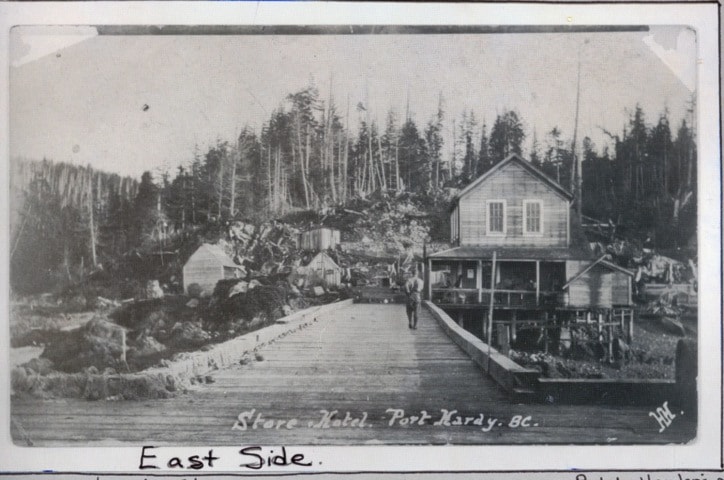I would like to thank everyone for their very positive response to the history articles published in the Gazette. I receive a lot of feedback and it seems that many other North Islanders share my interest and passion in our local history. I was asked if I could focus the next article on the “Hardy Bay Lands Company,” with this being the 100th anniversary of the Port Hardy land scam. These activities created great hardship and sorrow while also helping to further establish the community that eventually became the Port Hardy that we know today.
------------
Until the early 1900s, Hardy Bay existed as a small community on the east side of the Bay, opposite the current townsite.
The population was more or less stable with a few families that operated a small hotel and a couple of stores.
In the late 1800s and early 1900s the government was trying to encourage settlement on the coast, pre-emptions were offered to homesteaders who agreed to make improvements, which usually included clearing a portion of the land and building a house.
Many locations around the north coast of the island, from Hardy Bay around to Quatsino, were settled by homesteaders in this period.
Much immigration to Canada was taking place at this time, and it was not uncommon for families to pick up and move to a new community.
In early 1912 the Hardy Bay Lands Company Ltd. was incorporated in Victoria. The company reported it had 1000 shares and $100,000 capital.
Its purpose was to promote the sale of land in Hardy Bay, across Canada, and even throughout the United Kingdom through advertisements, brochures and billboards.
Unfortunately, the advertising used to lure unsuspecting settlers into purchasing land in Hardy Bay was fraudulent and unscrupulous.
The advertising materials showed rolling farmland, established orchards, a rail line and a sea terminal — a far cry from reality in the rugged outpost community.
People who purchased lots believed they were buying land in a busy commercial centre.
Lots were advertised between $125 and $145 and were available for $40 down. Land was said to be “The finest area of farm land on Vancouver Island, especially for dairy purposes.”
Prospective buyers were told the announced construction of a new railway to the north end of the island was imminent, and land values would rise significantly in a short period of time.
The company even published a dubious newspaper — the Hardy Bay News — in 1913/1914.
It contained many world events interspersed with tidbits of local news, including a story of a local woman who fell 20-ft from a dock onto the rocky shore, but miraculously sustained no injuries.
Many families spent their savings to purchase a lot, and then booked passage on a steamer to Port Hardy with what livestock and farm equipment they could bring with them with the intent of starting a new life full of opportunity.
Unfortunately when they arrived they found a small community with little more than a hotel and a store, and a great vast forest wilderness. Some of the “properties” were actually located under water in the ocean.
By 1914 the company disappeared, along with its assets. No one ever successfully sued the Hardy Bay Lands Company.
Many of the settlers who arrived took one look at the town and decided to turn around and catch the next steamer back to Vancouver or Victoria. Many had to sell livestock to Alexander Lyon for money to pay for their passage back.
A number of families stayed and some obtained crown preemptions and cleared land to farm, a number moving to the area around Kains Lake.
The families of Alfred Moon and Peter Sandcock arrived in the spring of 1913, and after finding the land purchased from the Hardy Bay Lands Company was nonexistent, secured 156 acres at the mouth of the Tsulquate River. The horses they brought for the farming purposes ended up packing freight and mail over the trail to Coal Harbour and Quatsino Sound.
The Port Hardy family history book, A Dream Come True, noted a widow, Mrs. Fenton, arrived as a part of the land scam with her children.
The family stayed, but unfortunately was beset with tragedy: one son was killed in a logging accident, another was lost at sea during a trip to Seymour Inlet, one was drinking and fell off his boat at Rivers Inlet and drowned, and yet another died of a heart attack.
The Hardy Bay lands scam did have the effect of contributing to an increase in the population of the town. By 1919 there were approximately 23 families and a number of single men living in the community.
Brenda McCorquodale lives in Port Hardy and is a North Island history enthusiast. If you have any stories or North Island information that you’d like to share, please e-mail Brenda at storeysbeach@gmail.com.
